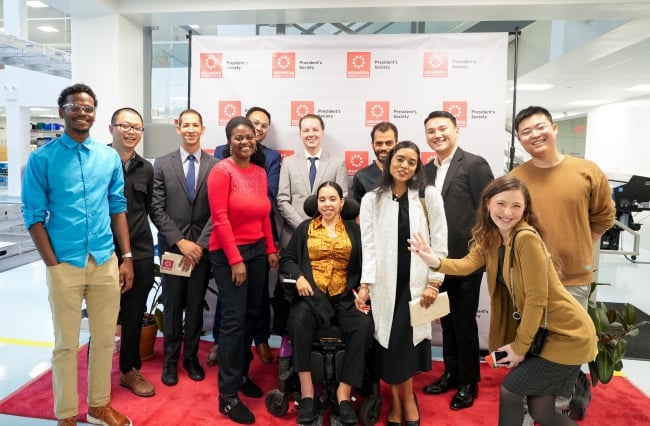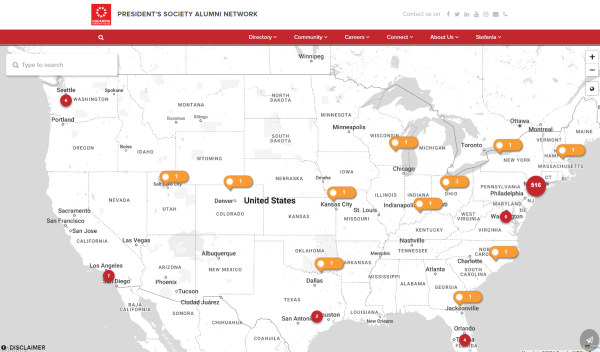You have /5 articles left.
Sign up for a free account or log in.

Alumni of the LaGuardia Community College President’s Society gather to celebrate the program’s 10th anniversary and the announcement of its new alumni network.
LaGuardia Community College
LaGuardia Community College, part of the City University of New York system, is looking for new ways to keep its successful alumni connected long after they leave Queens. And a new digital platform, the President’s Society Alumni Network, is designed to do just that.
Announced in late September and launched in January as part of a 10th anniversary celebration for the college’s President’s Society—a professional development, leadership and college ambassador program—the alumni network enables both current students and veteran alumni to link up.
Participants on the front end of the platform can create a profile, share their résumé and message one another, whether it’s to reconnect with an old classmate or ask a seasoned veteran for advice. And administrators on the back side can send out mass messages, collect student outcome data and facilitate connections with major industry partners.
Karen Dubinsky, LaGuardia’s chief engagement officer and a co-founder of the society, describes the new tool as a circle that benefits all involved.
“The alumni network gives current students role models and opportunities. It gives alums a way to give back and stay in touch. And it gives the college access to a vital alumni network and the corporations where they work,” she says.
How the overall program works: Introduced in 2013, the President’s Society has provided more than 600 community college students with programming to help them gain the confidence and skill sets needed not only to be leaders on campus as they earn a degree, but also as they enter the workforce.
And it’s proven to pay off. About 95 percent of society alumni graduated from LaGuardia with an associate degree, and 88 percent have either already earned or are currently pursuing a bachelor’s degree.
Any student can apply as long as they are enrolled in 12 or more credits and hold a GPA of 3.0 or higher, but only about 30 are selected each year based on stamina, involvement, time management skills and ability to envision future goals. Once admitted to the society, participants attend 25 weekly workshops where they gain soft skills for networking, receive bachelor’s degree transfer counseling, go on cultural outings and more.
The new network: Now, via the alumni network, Dubinsky hopes that students’ involvement with the program will stretch far beyond those 25 weeks.

A map that is part of the alumni network platform shows where former students are located across the country and around the world.
LaGuardia Community College
She says the idea emerged as she and Stefania Dinu, a program alum who now oversees the society’s day-to-day operations, were planning a reunion party.
“All of a sudden, we realize, we’ve got alums working at American Express and Goldman Sachs and Accenture and Google and Microsoft … but we had no system to get hold of them,” Dubinsky says.
Dinu proposed the concept of an interactive alumni software platform in response, and the college’s administrators were quickly on board with the new idea.
“Moving everything from Excel to Almabase, the platform that we moved forward with … just made our work efficient,” Dinu says. “We knew this was the way to go.”
What’s the need: The alumni network provides an extension of many of the same factors that drove the initiation of the President’s Society program in the first place.
A majority of LaGuardia’s students are from low-income backgrounds, with 54 percent of enrollees having a household income of less than $30,000 per year. They also represent a large immigrant population, coming from more than 130 different countries. And many are just dipping their toes into the water of the postgraduate American workplace.
While many community colleges lack the “robust” alumni groups that have become a common practice among their four-year peers, LaGuardia is trying to change that.
“It gives students the skills, the connections and the confidence to get ahead in a world that is new to them,” Dubinsky says.
The impact: So far, the program is off to a strong start. Just two months in, the college has already captured about 150 alumni (or 25 percent of total program participants) and can track things including where they are located and what kind of work or further studies they are pursuing.
It has led to several fruitful interactions, too.
One alum, who now works as teaching assistant at the Museum of Natural History in Manhattan, used the network to connect with Dinu and arrange an outing for current students to learn about opportunities in the museum industry. And another reached out to encourage current students to apply for an internship in their department at a New York–based investment firm.
It’s also inspired donors to boost their gifts to the university. In one case a benefactor quintupled their gift, raising it from $20,000 over four years to $100,000 over five, after hearing about the new program.
“A vital alumni network is proof of performance for the college,” Dubinsky says. “That helps us raise money, it helps us get jobs and it helps students understand the value of being able to come to a community college.”
What has your community college done to form or grow an active alumni network that is giving back to current students? Tell us about it.




